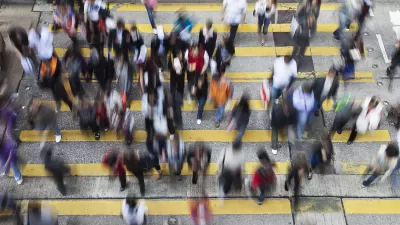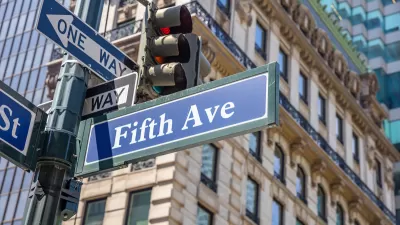Laura Laker surveys efforts to make cities more walkable, from Melbourne's converted alleys to Guangzhou's 60-mile ecological corridor.

According to Walk Score, New York is the nation's most walkable city, partly because it was built before the complete dominance of the car, but partly because of concerted efforts to make the streets safer and more interesting for walkers. Janette Sadik-Khan, the city's former transportation commissioner, is quoted in Laura Laker’s Guardian article saying, "We changed the city from places people wanted to park to places people wanted to be – street space to seat space."
Common strategies unite pedestrian-friendly cities around the world. They include slowing down and removing cars to make space for a walking pace. "Melbourne, in Australia, transformed unloved alleyways used primarily for rubbish into its now famous 'laneways' – buzzing outdoor seating for coffee shops and restaurants," Laker writes.
Taking space away from cars and parking also makes places more walkable by improving air quality. "Guangzhou in China has among the highest levels of walking in the world. Redevelopment of the banks of the Pearl River to create an ecological corridor has connected six paths, resulting in 60 miles of greenways," Laker reports.
FULL STORY: Where is the world's most walkable city?

Planetizen Federal Action Tracker
A weekly monitor of how Trump’s orders and actions are impacting planners and planning in America.

San Francisco's School District Spent $105M To Build Affordable Housing for Teachers — And That's Just the Beginning
SFUSD joins a growing list of school districts using their land holdings to address housing affordability challenges faced by their own employees.

The Tiny, Adorable $7,000 Car Turning Japan Onto EVs
The single seat Mibot charges from a regular plug as quickly as an iPad, and is about half the price of an average EV.

Seattle's Plan for Adopting Driverless Cars
Equity, safety, accessibility and affordability are front of mind as the city prepares for robotaxis and other autonomous vehicles.

As Trump Phases Out FEMA, Is It Time to Flee the Floodplains?
With less federal funding available for disaster relief efforts, the need to relocate at-risk communities is more urgent than ever.

With Protected Lanes, 460% More People Commute by Bike
For those needing more ammo, more data proving what we already knew is here.
Urban Design for Planners 1: Software Tools
This six-course series explores essential urban design concepts using open source software and equips planners with the tools they need to participate fully in the urban design process.
Planning for Universal Design
Learn the tools for implementing Universal Design in planning regulations.
Smith Gee Studio
City of Charlotte
City of Camden Redevelopment Agency
City of Astoria
Transportation Research & Education Center (TREC) at Portland State University
US High Speed Rail Association
City of Camden Redevelopment Agency
Municipality of Princeton (NJ)




























